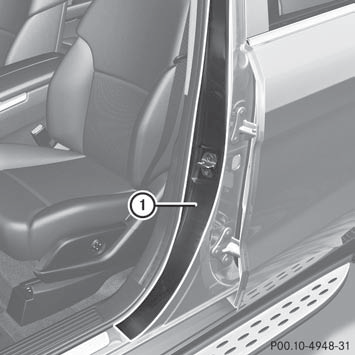Instruction labels for tires and loads
 WARNING
WARNING
Do not overload the tires by exceeding the
specified load limit as indicated on the Tire
and Loading Information placard on the
driver's door B-pillar. Overloading the tires
can overheat them, possibly causing a
blowout. Overloading the tires can also result
in handling or steering problems, or brake
failure.
Two instruction labels on your vehicle show the maximum possible load.
(1) The Tire and Loading Information placard on the B-pillar on the driver's side. The Tire and Loading Information placard shows the maximum permissible number of occupants and the maximum permissible vehicle load. It also contains details of the tire sizes and corresponding pressures for tires mounted at the factory.
(2) The vehicle identification plate is on the B-pillar on the driver's side. The vehicle identification plate informs you of the gross vehicle weight rating. It is made up of the vehicle weight, all vehicle occupants, the fuel and the cargo. You can also find information about the maximum gross axle weight rating on the front and rear axle.
The maximum gross axle weight rating is the maximum weight that can be carried by one axle (front or rear axle). Never exceed the maximum load or the maximum gross axle weight rating for the front or rear axle.

1 B-pillar, driver's side
See also:
Design: a muscular, self-assured presence
The modified design reflects the effortless superiority and power of the
Mercedes-Benz S-Class Saloon. It is characterised by the more pronounced
arrow-shape of the radiator grille, plus a new fro ...
System self-test
After you have switched on the ignition, the
system carries out a self-diagnosis.
WARNING
A malfunction in the system has been
detected if one of the following conditions
occurs:
• the indi ...
Flat tire
The "Breakdown assistance" section
contains information and notes
on how to deal with a flat tire. It also provides
instructions on changing a wheel or mounting
the spare wheel/emerg ...
